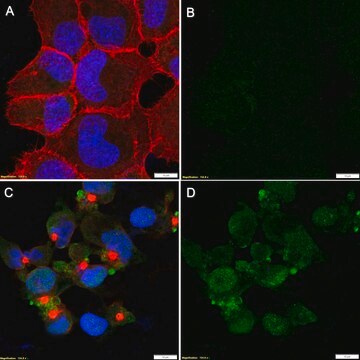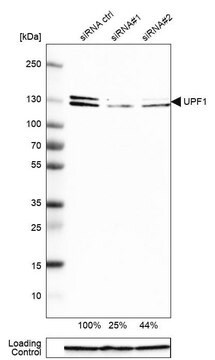07-1016
Anti-phospho-Upf1 (Ser1127) Antibody
from rabbit, purified by affinity chromatography
Sinônimo(s):
Regulator of nonsense transcripts 1, ATP-dependent helicase RENT1, Nonsense mRNA reducing factor 1, NORF1, Up-frameshift suppressor 1 homolog, hUpf1
About This Item
Produtos recomendados
fonte biológica
rabbit
Nível de qualidade
forma do anticorpo
affinity isolated antibody
tipo de produto de anticorpo
primary antibodies
clone
polyclonal
purificado por
affinity chromatography
reatividade de espécies
mouse, human
reatividade da espécie (prevista por homologia)
chicken (based on 100% sequence homology), zebrafish (based on 100% sequence homology), yeast (based on 100% sequence homology), bovine (based on 100% sequence homology), rat (based on 100% sequence homology)
técnica(s)
immunoprecipitation (IP): suitable
western blot: suitable
nº de adesão NCBI
nº de adesão UniProt
Condições de expedição
wet ice
modificação pós-traducional do alvo
phosphorylation (pSer1127)
Informações sobre genes
human ... UPF1(5976)
Descrição geral
Especificidade
Imunogênio
Aplicação
Peptide Inhibition Analysis: A 1:1,000 dilution from a representative lot blocked phospho-Upf1 (Ser1127) in NIH3T3 treated with Calyculin A and Okadaic Acid.
Immunoprecipitation Analysis: 5 µg from a representative lot immunoprecipitated phospho-Upf1 (Ser1127) in NIH3T3 treated with Calyculin A and Okadaic Acid.
Qualidade
Western Blotting Analysis: A 1:1,000 dilution of this antibody detected phospho-Upf1 (Ser1127) in 10 µg lysate from NIH3T3 treated with Calyculin A (50 nM) and Okadaic Acid (500 nM) for 30 minutes.
Descrição-alvo
Outras notas
Não está encontrando o produto certo?
Experimente o nosso Ferramenta de seleção de produtos.
Código de classe de armazenamento
12 - Non Combustible Liquids
Classe de risco de água (WGK)
WGK 1
Ponto de fulgor (°F)
Not applicable
Ponto de fulgor (°C)
Not applicable
Certificados de análise (COA)
Busque Certificados de análise (COA) digitando o Número do Lote do produto. Os números de lote e remessa podem ser encontrados no rótulo de um produto após a palavra “Lot” ou “Batch”.
Já possui este produto?
Encontre a documentação dos produtos que você adquiriu recentemente na biblioteca de documentos.
Nossa equipe de cientistas tem experiência em todas as áreas de pesquisa, incluindo Life Sciences, ciência de materiais, síntese química, cromatografia, química analítica e muitas outras.
Entre em contato com a assistência técnica








